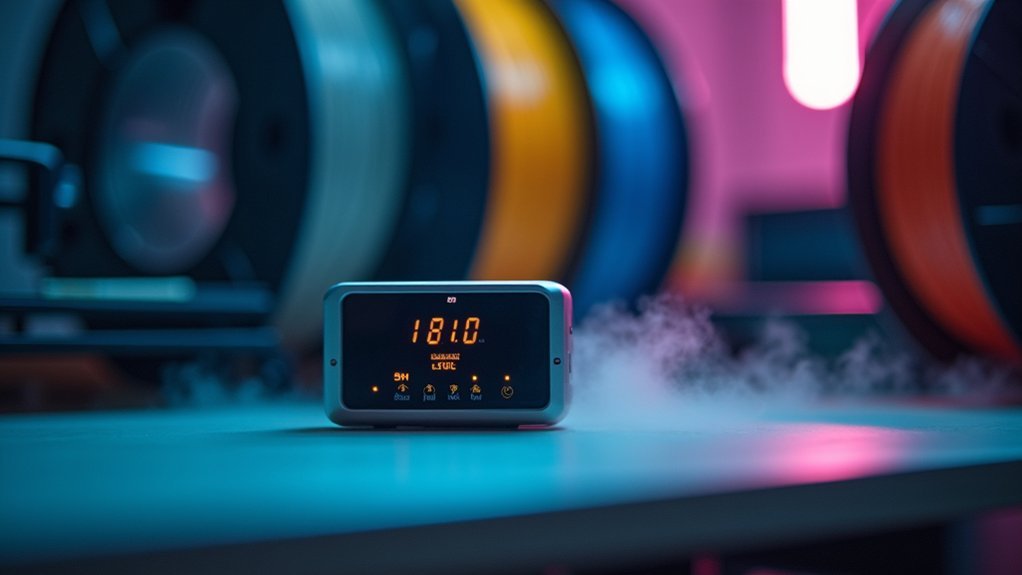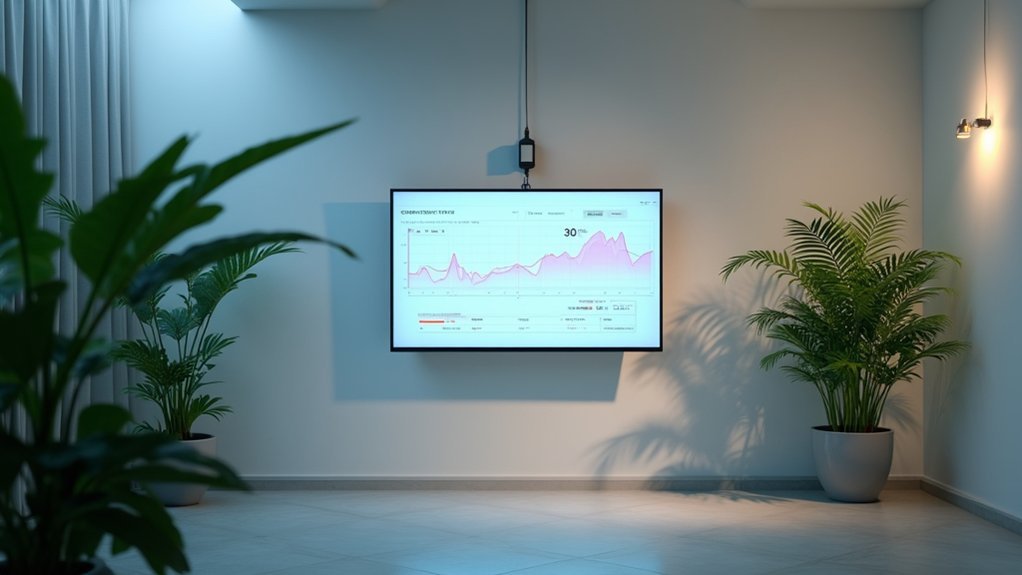You can monitor VOC exposure levels effectively by installing real-time detection sensors in your workspace that alert you when concentrations exceed safe thresholds. Use portable air quality monitors to test multiple locations, implement continuous TVOC measurement systems for 24/7 surveillance, and deploy photoionization detectors for specific VOC identification. Set up automated alert systems, establish baseline measurements before activities, and track exposure data over time to identify dangerous patterns. These thorough monitoring strategies will help you discover additional protective measures.
Install Real-Time VOC Detection Sensors in Your 3D Printing Area

When you’re operating 3D printers regularly, installing real-time VOC detection sensors in your workspace provides continuous monitoring of air quality by tracking harmful compounds released from filaments and adhesives.
These sensors measure VOC levels in parts per million or micrograms per cubic meter, alerting you when concentrations exceed safe thresholds below 0.3 mg/m³.
You’ll find that Metal Oxide Semiconductor sensors and Photoionization Detection technology effectively identify harmful VOCs during 3D printing operations.
Installing these systems protects your health by preventing exposure symptoms like headaches and respiratory irritation while ensuring regulatory compliance.
Remember to calibrate and maintain your sensors regularly, as accuracy diminishes without proper upkeep, compromising your ability to monitor air quality effectively.
Use Portable Air Quality Monitors for Multi-Location Testing
Portable air quality monitors give you the flexibility to assess VOC levels across different rooms, buildings, or outdoor spaces without being tied to a single location.
These compact, battery-operated devices provide real-time monitoring of Total Volatile Organic Compounds (TVOCs), measuring levels in micrograms per cubic meter or parts per million.
Battery-powered portable monitors deliver instant TVOC readings in real-time, displaying contamination levels in both micrograms per cubic meter and parts per million.
You can easily move your indoor air quality monitor between your home, office, and schools to identify pollution hotspots and track exposure patterns over time.
Most portable monitors include data logging features that help you spot VOC spikes from specific activities like cleaning or product use.
User-friendly apps deliver instant alerts when levels exceed the recommended 500 µg/m³ threshold, enabling quick responses to protect your health and safety.
Implement Continuous TVOC Measurement Systems

While portable monitors offer flexibility, continuous TVOC measurement systems provide uninterrupted surveillance of your indoor air quality around the clock.
These advanced systems use sophisticated sensor technology to detect TVOCs (Total Volatile Organic Compounds) in real-time, measuring concentrations in micrograms per cubic meter or parts per million.
When VOC levels exceed safe thresholds, the system immediately alerts you to harmful chemicals in your environment.
You’ll need to calibrate your sensors regularly to guarantee accurate readings.
Modern systems can integrate with your building’s ventilation controls, automatically adjusting airflow when concentrations rise.
This monitoring can help you identify pollution sources and implement targeted interventions.
Advanced sensors from manufacturers like Sensirion enhance detection capabilities, providing thorough data for effective air quality management.
Deploy Photoionization Detectors (PID) for Specific VOC Identification
For pinpoint identification of specific VOCs in your environment, photoionization detectors (PIDs) deliver unmatched precision through ultraviolet light technology that ionizes airborne compounds.
These VOC sensors detect volatile organic compounds at parts per billion levels, providing real-time monitoring capabilities essential for maintaining air quality standards.
PIDs excel at identifying hazardous substances like methylene chloride and benzene while offering broad-spectrum analysis.
Here’s how to maximize their effectiveness:
- Calibrate regularly to prevent sensor drift and maintain measurement accuracy
- Position strategically in industrial settings and emergency response locations
- Monitor continuously for immediate detection of harmful concentration spikes
- Document readings to track exposure trends and compliance requirements
You’ll gain critical data for protecting public health through immediate detection of dangerous volatile organic compounds in your working environment.
Set Up Automated Alert Systems for Dangerous VOC Concentration Levels

You’ll need to configure specific threshold levels that trigger alerts when VOC concentrations exceed safe limits, typically starting at 0.3 mg/m³ for low exposure warnings.
Your notification system should deliver real-time alerts through multiple channels like mobile apps, email, or building management dashboards to guarantee immediate awareness of dangerous conditions.
You must also establish clear emergency response protocols that automatically activate ventilation systems and guide occupants on appropriate safety measures when critical VOC levels are detected.
Threshold Configuration Methods
When VOC concentrations reach dangerous levels, automated alert systems serve as your first line of defense against potential health hazards. Proper threshold configuration methods guarantee your monitoring technologies respond effectively to protect indoor air quality.
You’ll need to establish specific threshold values based on individual VOC health impacts. Here’s how to configure your automated alert systems:
- Set baseline thresholds at 0.3 mg/m³ for low-level exposure warnings
- Configure VOC-specific limits based on known toxicity levels for different compounds
- Integrate Photo Ionization Detection (PID) or Flame Ionization Detection (FID) technologies for continuous real-time monitoring
- Connect alerts to building management systems for automatic ventilation activation
Regular analysis of historical VOC levels helps you refine these thresholds, guaranteeing your system adapts to changing environmental conditions while maintaining peak protection.
Real-Time Notification Systems
Real-time notification systems transform your VOC monitoring setup from passive data collection into an active safety network that protects occupants instantly.
These systems use air quality sensors to continuously track Total Volatile Organic Compounds and automatically trigger alerts when concentrations exceed safe thresholds. You’ll receive immediate notifications through mobile apps or email, enabling quick responses to elevated VOC levels.
Modern automated alert systems integrate seamlessly with building management software, automatically activating ventilation or prompting window opening when indoor air quality becomes hazardous.
This proactive approach prevents health symptoms before they develop, particularly vital in schools and offices. You’ll also maintain regulatory compliance through documented responses to VOC exceedances, creating thorough air quality management records that demonstrate your commitment to occupant safety.
Emergency Response Protocols
Because dangerous VOC concentrations can escalate rapidly from safe to hazardous levels, establishing robust emergency response protocols with automated alert systems becomes your critical line of defense against exposure risks.
These systems integrate seamlessly with air quality sensors to provide immediate notifications when threshold limits are exceeded.
Your thorough action protocols should include:
- Immediate Alert Activation – Configure automated alert systems to trigger instant notifications across all communication channels when VOC concentrations reach predetermined danger levels.
- Personnel Safety Measures – Implement evacuation procedures and restrict access to contaminated areas until levels return to safe parameters.
- Ventilation Response – Automatically activate enhanced air circulation systems to reduce concentrations quickly.
- Staff Training – Confirm all personnel understand emergency response procedures to minimize health risks during VOC exposure incidents.
Utilize Metal Oxide Semiconductor Sensors for Cost-Effective Monitoring
While sophisticated VOC detection equipment can cost thousands of dollars, Metal Oxide Semiconductor (MOS) sensors offer an accessible alternative that won’t break your budget. These VOC sensors use metal oxide films that change resistance when exposed to volatile organic compounds, providing reliable monitoring for indoor air quality applications.
| Feature | Benefit |
|---|---|
| Cost-effective design | Budget-friendly continuous monitoring |
| Broad detection range | Identifies benzene, toluene, and other common VOCs |
| Low humidity tolerance | Functions reliably in varying moisture conditions |
| Real-time feedback | Instantly indicates changing VOC levels |
| Simple installation | No complex setup required |
You’ll find MOS sensors particularly useful for ongoing surveillance of total volatile organic compounds, though they won’t identify specific individual gases with high precision.
Create VOC Baseline Measurements Before Starting Print Jobs
Before you fire up your printing equipment, you’ll need to conduct pre-print air quality testing to establish your workspace’s natural VOC levels.
This process involves establishing reference VOC levels by taking measurements at different times throughout the day, accounting for variables like temperature and occupancy patterns.
You should document initial TVOC readings in µg/m³ or ppm units, creating a reliable baseline that’ll help you identify any emissions spikes during actual printing operations.
Pre-Print Air Quality Testing
Since establishing accurate VOC monitoring requires a clear reference point, you’ll need to conduct pre-print air quality testing to create baseline measurements before starting any print jobs.
This process involves using TVOC sensors to assess your workspace’s initial air quality conditions.
Effective pre-print testing follows these key steps:
- Measure baseline VOC levels using calibrated TVOC sensors before equipment activation
- Target readings below 0.3 mg/m³ to establish safe starting conditions and minimize health risks
- Test ventilation systems to guarantee proper airflow before introducing printing chemicals
- Document all measurements for accurate comparison during and after print operations
Regular pre-print testing helps you identify when VOC levels spike during printing, enabling quick interventions to protect worker safety and maintain acceptable air quality standards.
Establishing Reference VOC Levels
Creating accurate baseline VOC measurements requires you to capture your workspace’s natural air quality profile during normal operating conditions, but without any active printing processes.
You’ll need to measure Total Volatile Organic Compounds during typical operational hours to establish reliable reference points. Use professional monitoring equipment like photoionization detectors or flame ionization detectors for precise readings.
Record TVOC levels in micrograms per cubic meter, targeting measurements below 0.3 mg/m³ for acceptable air quality standards. Your VOC sensor should document concentrations before any print jobs begin, creating a clear comparison baseline.
Regularly reviewing these baseline VOC levels helps you identify emission trends and spikes related to specific printing materials or processes over time.
Document Initial TVOC Readings
When you’re ready to document initial TVOC readings, position your calibrated sensor in the center of your workspace and record measurements for at least 15 minutes during normal operating conditions.
These baseline levels establish your reference point for tracking air quality changes throughout your print operations.
Follow these essential steps for accurate documentation:
- Use consistent environmental conditions – Record initial readings during typical operating hours with similar room temperatures.
- Verify VOC sensors calibration – Confirm your monitoring equipment provides reliable, accurate measurements.
- Document measurements in standard units – Record all readings in µg/m³ or ppm for clear comparisons.
- Schedule regular baseline updates – Revisit TVOCs measurements when materials, processes, or workspace conditions change.
Proper initial readings form the foundation for effective VOC exposure monitoring.
Monitor VOC Levels in Real-Time During Different Filament Types
How can you guarantee your 3D printing workspace remains safe when switching between different filament materials? You’ll need real-time monitoring systems that track VOC levels continuously during your printing sessions. Environmental sensors measuring Total Volatile Organic Compounds (TVOCs) in µg/m³ provide immediate feedback about harmful VOC emissions from various filaments.
| Filament Type | Typical TVOC Level | Risk Assessment |
|---|---|---|
| PLA | 50-150 µg/m³ | Low Risk |
| ABS | 200-500 µg/m³ | Moderate Risk |
| PETG | 100-250 µg/m³ | Low-Moderate Risk |
Photoionization detectors offer instant alerts when emissions exceed safe thresholds. This real-time monitoring approach lets you identify which specific materials contribute to elevated readings, enabling informed decisions about filament selection and when to activate ventilation systems during 3D printing operations.
Establish Regular Air Sampling Schedules With Professional Equipment
While real-time monitoring provides immediate feedback, you’ll need professional air sampling equipment to obtain detailed VOC analysis that identifies specific compounds and their concentrations.
Professional equipment like gas chromatographs or mass spectrometers delivers precise measurements that help you understand your indoor air quality thoroughly.
To establish effective monitoring schedules:
- Schedule sampling during peak usage times – Conduct air sampling after renovations, cleaning, or heavy equipment use when VOC emissions typically spike.
- Sample during afternoon or evening hours – Heat and humidity increase off-gassing from materials and products.
- Maintain regular intervals – Monthly or quarterly sampling establishes baseline VOC levels and identifies trends.
- Document all measurements – Track data to assess mitigation strategies’ effectiveness and guarantee consistent monitoring of your environment’s air quality.
Track VOC Exposure Data Over Time to Identify Patterns and Trends
Professional air sampling provides the foundation for thorough VOC monitoring, but collecting this data systematically over extended periods reveals valuable insights you can’t capture from isolated measurements.
You’ll establish baseline VOC levels by recording exposure data consistently, enabling you to track deviations that signal air quality changes or new contamination sources like renovations or furniture additions.
Advanced monitoring technologies that integrate VOC levels with temperature and humidity data offer extensive environmental analysis.
Comprehensive environmental monitoring systems combine VOC detection with climate sensors to deliver complete indoor air quality analysis.
You’ll discover seasonal patterns and daily fluctuations in your VOC data, allowing targeted mitigation during peak exposure times. This historical analysis informs critical decisions about ventilation strategies, product selections, and overall indoor air quality management.
Regular data interpretation transforms raw measurements into actionable intelligence for protecting your health and optimizing your indoor environment.
Frequently Asked Questions
How to Monitor VOC Levels?
You can monitor VOC levels using TVOC sensors for real-time readings, handheld meters for portable assessments, or fixed detectors for continuous monitoring. Check the VOC Index regularly—values above 100 indicate worsening air quality.
How Do You Test for VOC Exposure?
You can test for VOC exposure using handheld meters for real-time readings or collection kits that send air samples to laboratories. Test in afternoons when heat increases off-gassing for most accurate results.
What Methods Are Used to Measure VOC?
You’ll find gas chromatographs and mass spectrometers measure individual VOCs precisely, while consumer monitors use MOx sensors for TVOC readings. Portable handheld meters provide real-time data, and lab testing kits offer detailed analysis.
Is There a VOC Detector?
Yes, you’ll find VOC detectors readily available as handheld electronic devices. They use photoionization or metal oxide sensors to measure volatile organic compounds in real-time, displaying concentrations in parts per million.





Leave a Reply